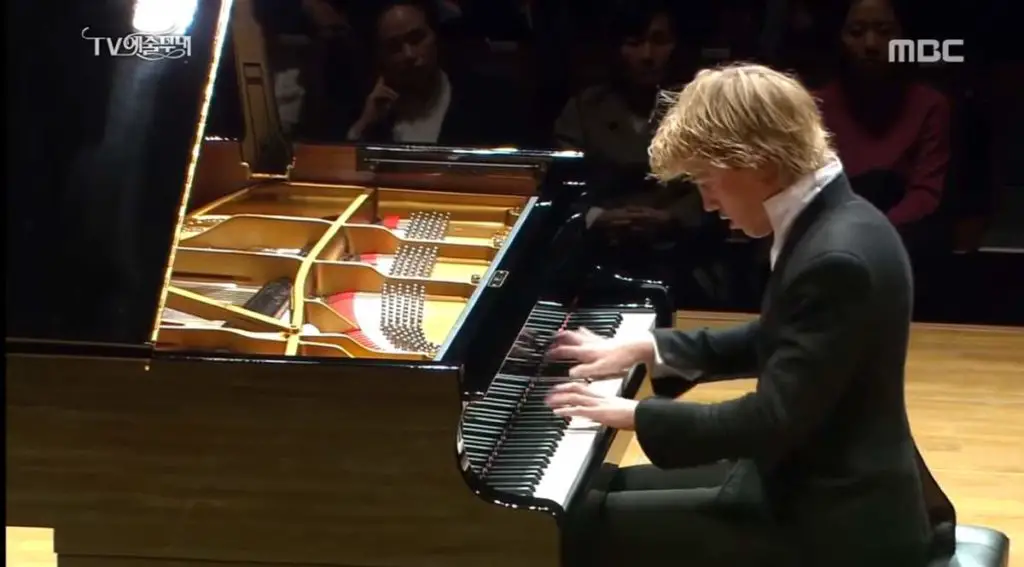Daniel Barenboim plays Ludwig Beethoven’s Piano Sonata No. 21 in C major, Op. 53, known as the Waldstein. From the Complete Beethoven Piano Sonatas Nos 1-32 cycle recorded in 1983-84.
Beethoven’s Piano Sonata No. 21
Beethoven’s Piano Sonata No. 21 in C major, Op. 53, commonly known as the “Waldstein Sonata,” is one of the composer’s most celebrated and technically demanding works for the piano. Named after Beethoven’s close friend and patron, Count Ferdinand Ernst Gabriel von Waldstein, the sonata was completed in 1804 during a period of remarkable creativity for Beethoven. This was the era in which he also composed some of his other monumental works, such as the “Eroica” Symphony and the “Appassionata” Sonata.
The Waldstein Sonata is noted for its innovative structure and the unprecedented technical demands it places on the performer. Its virtuosic passages, extensive use of the keyboard, and emotional depth make it a challenging but rewarding piece to both perform and listen to. It’s a work that requires not only technical mastery of the instrument but also a deep understanding of its underlying emotional and structural complexities.
Beethoven was pushing the boundaries of the piano sonata form with this piece, both in terms of length and thematic development. The work represents a departure from classical norms, featuring bold harmonic choices and a complex interplay of themes that are developed and transformed throughout. The sonata’s rich harmonic palette and rhythmic complexities contribute to its dramatic and emotional weight. The grandeur and expansiveness of the music reflect Beethoven’s ambitions not just for the sonata form but for the capabilities of the piano itself.
The Waldstein Sonata also represents a personal triumph for Beethoven, who was grappling with increasing deafness at the time. Despite his physical limitations, the sonata is a testament to his imaginative genius and his ability to transcend the constraints of his condition. The work resonates with a sense of struggle but also triumph, mirroring perhaps Beethoven’s own life circumstances.
Interestingly, the Waldstein Sonata was originally composed with a lengthy Andante section, which Beethoven later decided to remove. This excised portion eventually became the Andante favori, WoO 57, a separate piece altogether. Beethoven’s decision to make this cut perhaps speaks to his relentless quest for structural and emotional coherence in his work.
In the broader context of Beethoven’s oeuvre and the history of classical music, the Waldstein Sonata is often considered a seminal work that helped pave the way for Romanticism. It challenges traditional notions of form and expression, offering a new paradigm for what piano music could achieve in terms of emotional depth, structural innovation, and virtuosic display.
Beethoven’s Piano Sonata No. 21 “Waldstein” has three movements:
- Allegro con brio The first movement is in sonata form: it has a repeated exposition with two subject groups, a development section, a recapitulation, and a coda. It opens with repeated pianissimo chords in a straightforward but anxious rhythm, devoid of melody for two bars. It then swiftly ascends, followed by a three-note descent in the middle register and a four-note descent in the upper. This phrase is then repeated in B-flat major -a whole tone lower- a device Beethoven also used for the opening of Sonata No. 16 in G Major (Op. 31 No. 1). After a half cadence to the dominant (G major), the opening phrase returns again, but this time in a tremolo variation. The second subject group, marked dolce, is a chordal theme in E major, the mediant key. Modulation to the mediant for the second subject area is another feature shared by this sonata and Sonata No. 16. Later, Beethoven employed the same shift again (in the Hammerklavier Sonata, for example). For the recapitulation, Beethoven transposes the second subject into A major, quickly changing into A minor and then back to C major for the coda.
- Introduzione: Adagio molto (in F major) replaces the F major movement that Beethoven initially intended to use. Apparently, the composer renounced this part since it was too lengthy. He did, however, publish the movement separately, as the Andante Favori, WoO 57. The music gradually gets more agitated before calming down to segue into the last movement, the Rondo.
- Rondo. Allegretto moderato – Prestissimo The Rondo begins with a pianissimo melody played with crossed hands that soon returns fortissimo, over daringly fast scales in the left hand and a continuous trill on the dominant in the right, as described above. The second theme, a series of broken chords in triplets, is soon interrupted by a turbulent section in A minor that foreshadows the central episode. The music returns to C major, and the sweet theme is repeated, followed by a series of staccato octaves in C minor that mark the start of the central episode, one of the few cases where such a melodic change is seen, a tactic repeated in larger works like the Emperor Piano Concerto. Soon the octaves are accompanied by swirling triplets in the left and then the right hand. The music grows more tense and eventually reaches a cadence in C minor. The next section brings back the opening theme in chords and further develops it: it appears in A-flat major (bars 221 – 224), then F minor (bars 225 – 228) and then D-flat major (bars 229 – 232), when it is fragmented into shorter phrases (233 pickup – 238) and then transits into a quiet section with major 7th arpeggios, returning after much drama to the C major theme played fortissimo. The second theme reappears, followed by another characteristic long line of beautiful dance-like music. Another series of fortissimo chords announces a short, delicate pianissimo section: the movement seems to die away but then unexpectedly segues into a prestissimo coda that plays with the various themes of the movement, ending in a triumphant rush of grandeur.
Sources
- Piano Sonata No. 21 (Beethoven) on Wikipedia
